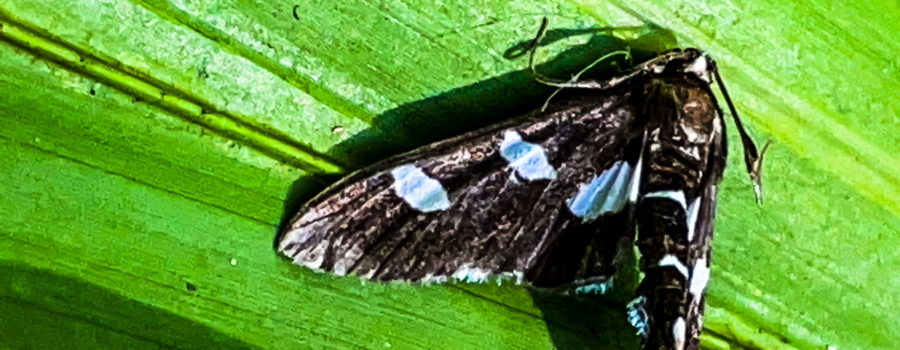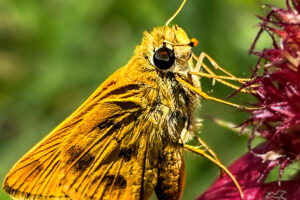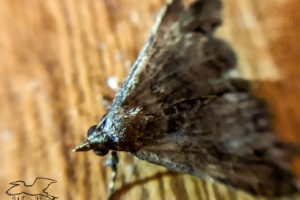Grape Leaf Folder Moths are Beautiful, but Have Destructive Caterpillars

Not long ago, I noticed a couple of small moths fluttering around in the dog house. There was also one dead one on top of one of the kennels, so I herded the live ones out. I’m honestly not sure how they got in, but I think they were trying to get out, because once they were out one of them settled on a palmetto leaf as if resting, so I took the opportunity to get some pics. I really wasn’t sure what they were, so once the live one decided to go on it’s way, I also took some shots of the dead one at some angles that I couldn’t have gotten of the live one (mainly upside down). I was glad that I did because some of those shots were very helpful in the identification process. A little research and a run through the Picture Insect app got me the identification of a grape leaf folder moth (Desmia funeralis). Some people also call this moth a grape leaf roller. It’s a fairly common moth found in most of the United States and southern Canada.

Grape leaf folders generally have three generations a year. The adults are pretty harmless and may even be minor pollinators, but the larvae can be problematic. The larvae or caterpillars feed mainly on grape leaves and can be found on both wild grapes and commercial grapes. When first hatched, they nibble the leaf edges, but as soon as they are large enough, they use silk ties to fold the leaves over themselves so that they can feed from inside the protective tube. The damage they cause is very characteristic, leaving patches of affected leaves skelatonized. At night they will move to new leaves and roll themselves up again. When ready to pupate, they will actually cut the leaf edges and make a small envelope in which they encase themselves. Since they spend daylight inside the rolled leaves, the larvae themselves are difficult to spot. A small infestation can be pretty insignificant, but larger numbers of caterpillars can cause enough leaf damage to reduce grape production. Grapes can be damaged directly by too much sun exposure, or production can be lowered because vines are spending too much energy on leaf replacement.

Besides grape leaves, grape leaf folder larvae may feed on the leaves of redbud trees and evening primrose bushes. In those species the damage is usually minimal. Interestingly, adult grape leaf folder moths fly during the day instead of at night like most other moths. As stated earlier, the adults are harmless and in addition to being minor pollinators, they also provide food for predators such as spiders, lizards, insectivorous birds, and small rodents. They are fairly short lived and spend most of that time focused on reproduction. Once I learned more about these moths, I wasn’t surprised to find them around here. We have many redbuds in the area as well as wild grapes. Both species are just putting out new green leaves, with the redbuds being ahead of the wild grapes, but as the season continues, I’m going to watch for rolled and skelatonized leaves and see if I can’t find some caterpillars, too.






Recent Comments